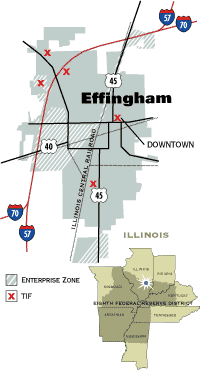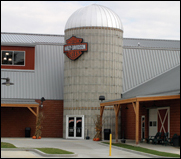Community Profile: Effingham, Ill., Uses Tax Breaks To Bounce Back
|
|||||||||||||||||||||||||||||||||||||||
World Color Press shut down at the end of 2003. Fedders, the air-conditioning manufacturer, already had shifted its production facility to China. Effingham lost about 1,200 manufacturing jobs just like that.
“There was a perfect opportunity for this town to die,” says Kevin Day, vice president of commercial lending at Midland States Bank in Effingham. “Losing that many jobs is a huge hit for a town like this.”
But the town didn’t die. Today, “For a small town, this is a booming place,” Day says.
Effingham is booming, thanks, in part, to an ambitious development plan. The city has built six industrial and business parks. Among the tenants is the largest Krispy Kreme mixing plant in the country. About 40 factories and warehouses have been built or expanded over the past decade.
The city has taken advantage of its central location and easy access to interstates 70 and 57.
“When you factor in the proximity of Effingham to much of the rest of the country, the low cost of doing business here compared to a major city and the overall labor pool, Effingham is a great place to do business,” says Mike McConnell, an executive with Sherwin-Williams. The company ships paint that it makes in Chicago to a 1.3 million-square foot distribution center that it built here 10 years ago. From here, paint is distributed to much of the Midwest.
Effingham also has attracted many businesses by offering Tax Increment Financing, or TIF, and by establishing an enterprise zone. TIF money comes from additional tax revenue that is generated from an improvement or new development on a site. This tax increment money goes to the city, which can use it to make street, water and sewer improvements in the TIF district.
Businesses can use the TIF money to demolish a property or fix it up, but not for new construction. When the TIF term expires, all the subsequent tax revenue goes to the regular taxing bodies—more than they would have received without the TIF.
In 1986, the Effingham City Council voted to use TIF to strengthen the local economy. The Effingham TIF District No. 1 generates tax revenue from three sources: property tax, city sales tax and state sales tax. Property and city sales taxes are collected by the city and are put into a special fund. Approximately 20 percent of the state sales tax is appropriated to the city and is again put into a special account.
Following the local economic downturn in the 1990s, city officials decided that Effingham needed more than just one TIF district. Four more have since been formed.
To provide an additional boost, Illinois state legislators voted in 1988 to create an enterprise zone, covering the southern, western and northeastern sections of Effingham. Businesses can take advantage of 100 percent property tax abatement (10 years for industrial projects and three years for commercial projects), sales tax exemption on building materials, a waiver on building permit fees, an investment tax credit, jobs tax credit and more.
Todd Hull, the economic development director of Effingham and city TIF administrator, says, “In an ideal word, if we didn’t have TIF and enterprise zones, I would say that we could compete just fine because of our excellent geographic location. But we’re competing against other cities, and you need to offer incentives.”
But is Effingham giving away the farmland by putting so much of the city in a TIF district or enterprise zone? No way, says Greg Curl, president and chief executive officer of Crossroads Bank in Effingham.
“People here know what it takes to grow, and TIF is a part of the game,” Curl says. “If another town is offering TIF and you aren’t offering it, then, everything else being equal, the business will go to a town that has TIF.”
Some economists argue that revenue from a particular TIF project may fall short of projections made before the project was started, forcing the community to forgo other expenditures while it makes up for the shortfall. Also, because the TIF area does not generate any revenue early on, residents outside the area can end up paying for municipal services inside the area.
Jon Schafer, the owner of the downtown Baseball Card Connection shop, says he wants no part of TIF. He says business owners should spend their own money, rather than rely on TIF, to make building improvements.
“TIF helps the business owners who are not keeping up their property. I have made improvements to this building, but I spent my own money to do it,” Schafer says.
Hull counters that downtown is bustling, in part, because of TIF improvements. He also says that money collected from TIF has gone to help pay for local projects like the construction of a new high school.
Curl says the future looks good for Effingham. “The infrastructure is here, the transportation needs are here,” he says. “We still need to knock on more doors, though. We need to talk to more companies and tell them why Effingham is a good place to be.”
Views expressed in Regional Economist are not necessarily those of the St. Louis Fed or Federal Reserve System.
For the latest insights from our economists and other St. Louis Fed experts, visit On the Economy and subscribe.
Email Us




